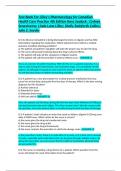Exam (elaborations)
Lilley's Pharmacology for Canadian Health Care Practice 4th Edition Kara Sealock ; Cydnee Seneviratne; Linda Lane Lilley; Shelly Rainforth Collins; Julie S. Snyder
- Course
- Institution
- Book
Lilley's Pharmacology for Canadian Health Care Practice 4th Edition Kara Sealock ; Cydnee Seneviratne; Linda Lane Lilley; Shelly Rainforth Collins; Julie S. Snyder
[Show more]



